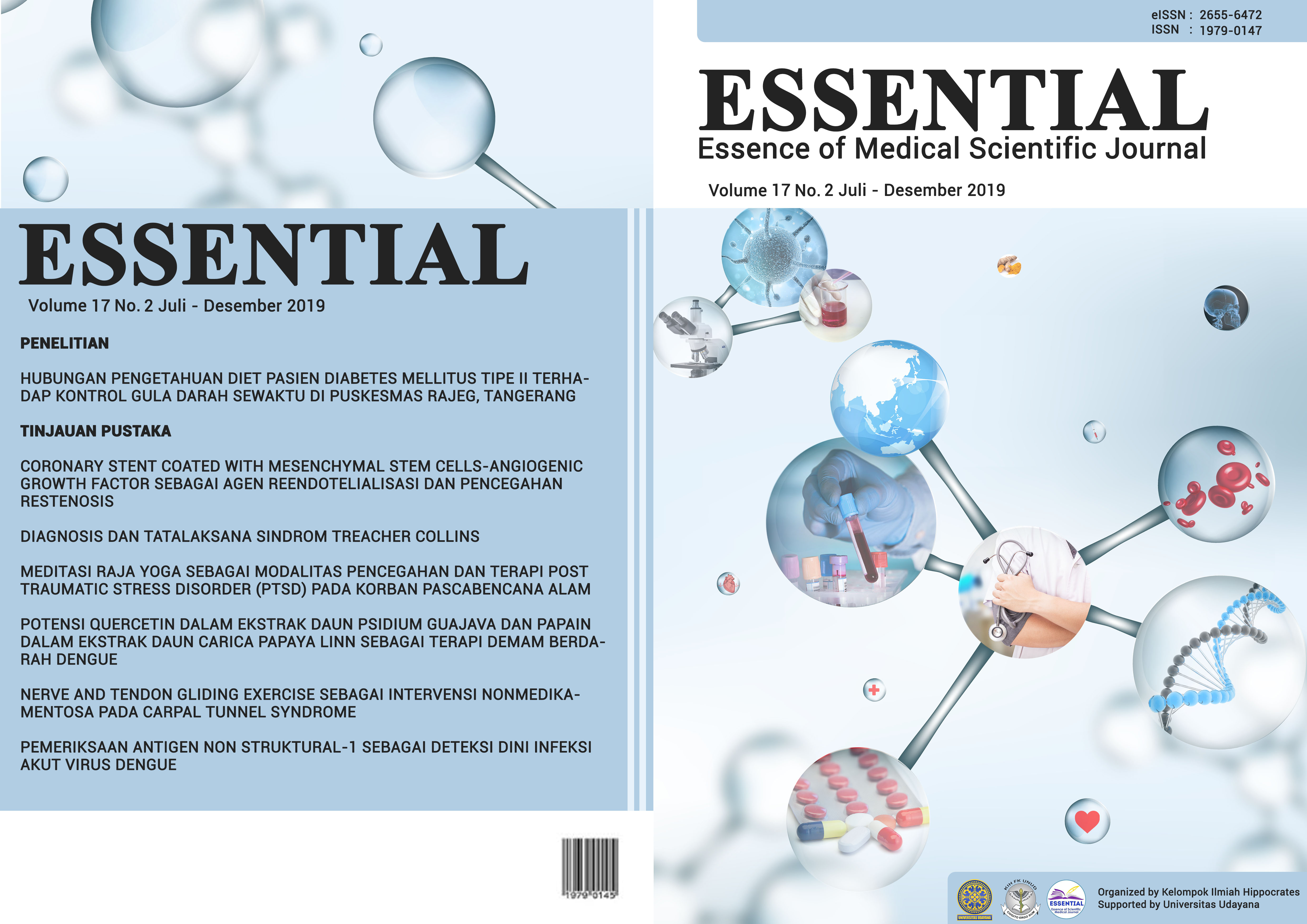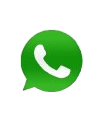POTENSI QUERCETIN DALAM EKSTRAK DAUN PSIDIUM GUAJAVA DAN PAPAIN DALAM EKSTRAK DAUN CARICA PAPAYA LINN TERHADAP TERAPI DEMAM BERDARAH DENGUE
Abstract
Abstrak
Latar Belakang : Menurut WHO pada tahun 2019, Demam Berdarah Dengue (DBD) mengenai 390 juta jiwa di seluruh dunia per tahun. Penyakit ini disebabkan oleh virus dengue yang ditransmisikan oleh nyamuk Aedes aegypti. Manifestasi klinis yang menjadi perhatian dalam penyakit ini adalah dehidrasi dan trombositopenia. Modalitas terapi yang ada saat ini hanya terapi simtomatik dan substitusi cairan. Oleh karena itulah diperlukan terapi yang dapat mengatasi keterbatasan ini. Tujuan : Tujuan dibuatnya literature review ini yaitu untuk menemukan modalitas terapi yang dapat mengatasi virus dengue dan trombositopenia. Metode : Studi ini menggunakan metode tinjauan pustaka dengan mengumpulkan sumber dari literatur ilmiah yang valid seperti PubMed dan Google Scholar. Hasil : Quercetin memiliki aktivitas antivirus dengan mereduksi persentase foci, pengkopian RNA, dan menghambat RNA polimerase yang penting dalam replikasi virus dengue. Selain itu, quercetin dapat menghambat enzim NS2B-NS3 protease, domain helikase, dan enzim ATPase. Papain dalam daun Carica papaya L. dapat menginduksi sitokin trombositik seperti IL-6 dan sekresi trombopoietin, sehingga hitung jumlah trombosit meningkat. Papain mampu meningkatkan ekspersi ALOX-12 yang berhubungan dengan peningkatan produksi megakaryosit dan trombosit. Quercetin diekstraksi dan difraksi dari daun Psidium guajava, kemudian hasil campuran diinkubasi. Papain diisolasi dari ekstrak daun Carica papaya L. dengan metode ultrasonication extraction. Kombinasi quercetin dan papain diadministrasikan secara peroral. Kesimpulan : Kombinasi quercetin dan papain memiliki potensi sebagai antivirus terhadap virus dengue dan memperbaiki kondisi trombositopenia. Penulis menyarankan untuk diadakan penelitan lebih lanjut terkait dosis dan efek samping yang dapat ditimbulkan.
Kata Kunci : Virus Dengue, Quercetin, Papain, Antivirus, Trombosit
Abstract
Background : According to WHO in 2019, Dengue Hemorrhagic Fever (DHF) affects 390 million people worldwide annually. This disease is caused by dengue virus transmitted by Aedes aegypti mosquito. Concerning clinical manifestations in this disease are dehydration and thrombocytopenia. Current therapeutic modalities only symptomatic therapy and fluid substitution. Therefore, a therapy that can overcome this limitation is required. Objective : The purpose of this literature review is to find therapeutic modalities that can overcome the dengue virus and thrombocytopenia. Methods : This study uses the literature review method by gathering sources from valid scientific literature such as PubMed and Google Scholar. Results : Quercetin has antiviral activity by reducing the percentage of foci, RNA copying, and inhibiting RNA polymerase which is important in dengue virus replication. Also, quercetin can inhibit NS2B-NS3 protease, helicase domain, and ATPase enzyme. Papain in Carica papaya L. can induce thrombocytic cytokines such as IL-6 and thrombopoietin secretion, so the thrombocyte count increases. Papain can increase the expression of ALOX 12 which is associated with increased production of megakaryocytes and thrombocytes. Quercetin is extracted and diffracted from Psidium guajava, then the mixed product is incubated. Papain is isolated from Carica papaya L. extract by ultrasonication extraction method. The combination of quercetin and papain is administered orally. Conclusion : Combination of quercetin and papain has potential as an antiviral against dengue virus and correct thrombocytopenia. The author recommends further research related to dose and side effects that can be caused.
Keywords : Dengue Virus, Quercetin, Papain, Antivirus, Thrombocyte
Downloads
References
1. Yoshikawa MJ & Kusriastuti R. Surge of dengue virus infection and chikungunya Fever in bali in 2010: the burden of mosquito-borne infectious diseases in a tourist destination. Trop Med Health. 2013;41:67–78.
2. WHO. Handbook for Clinical Management of Dengue. World Health Organization, Geneva, Switzerland. 2012; http://whqlibdoc.who.int/publications/2009/9789241547871_eng.pdf.
3. WHO. Dengue and Severe Dengue. World Health Organization, Geneva, Switzerland. 2019; https://www.who.int/news-room/fact-sheets/detail/dengue-and-severe-dengue.
4. Rodriguez-Roche R & Gould EA. Understanding the dengue virus and progress towards their control. BioMed Research International. 2013;1-20; http://dx.doi.org/10.1155/2013/690835
5. Haryanto B. Indonesia dengue fever: Status, vulnerability, and challenges. Current Topics in Tropical Emerging Diseases and Travel Medicine. 2018;5;81-92. http://dx.doi.org/10.5772/intechopen.82290
6. Megawati D, Masyeni S, Yohan B, Lestarini A, Hayati RF, Meutiawati F, Suryana K, Widarsa T, Budiyasa DG, Budiyasa N, Myint KSA, Sasmono RT. Dengue in Bali: Clinical characteristics and genetic diversity of circulating dengue viruses. PLOS Neglected Tropical Diseases. 2017;1-15.
7. Honda S, Saito M, Dimaano EM, Morales PA, Alonzo MT, Suarez LA, Koike N, Inoue S, Kumatori A, Natividad FF, Oishi K. Increased phagocytosis of platelets from patients with secondary dengue virus infection by human macrophages. The American Journal of Tropical Medicine and Hygiene. 2009;80(5):841-845.
8. Yacoub S, Mongkolsapaya J, & Screaton G. The pathogenesis of dengue. Current Opinion in Infectious Diseases. 2013;26(3):284-289.
9. Adikari TN, Gomes L, Wickramasinghe N, Wijesiriwardana N, Kamaladasa A, Shyamali NLA, Ogg GS, & Malavide GN. Dengue NS1 antigen contributes to disease severity by inducing interleukin (IL)-10 by monocytes. The Journal of Translational Immunology. 2016;184:90-100.
10. Kurane I, Matsutani T, Suzuki R, Takasaki T, Kalayanarooj S, Green S, Rothman AL, & Ennis FA. T-cell responses to dengue virus in humans. The Japanese Society of Tropical Medicine. 2011;39(4):45-51.
11. Azeredo EL, Monteiro RQ & Pinto LMO. Thrombocytopenia in dengue: Interrelationship between virus and the imbalance between coagulation and fibrinolysis and inflamatory mediators. Hindawi Publishing Corporation. 2015:1-16.
12. WHO. Dengue: Guidelines for Diagnosis , Treatment, Prevention and Control. World Health Organization, Geneva, Switzerland. 2009; http://whqlibdoc.who.int/publications/2009/9789241547871eng.pdf.
13. Anderson AS, Tamara RM, Silvana M, & Angelita DC. Aqueous extract of Psidium guajava leaves: phenolic compounds and inhibitory potential on digestive enzymes. Anais da Academia Brasileira de Ciências. 2017;89 (3):2155-2165.
14. Saptawati L, Febrinasari RP, Yudhani RD, Hudiyono, Faza AG, Luthfiani S, Ummiyati HS, Sudiro TM, & Dewi BE. In vitro study of eight Indonesian plants extracts as anti Dengue virus. Health Science Journal of Indonesia. 2017;8(1): 12-18.
15. Zhang W, Wang J, Chen Y, Zheng H, Xie B, & Sun Z. Flavonoid compounds and antibacterial mechanisms of different parts of white guava (Psidium guajava L. cv. Pearl). Natural Product Research. 2018:2-3.
16. Zandi K, Teoh BT, Sam SS, Wong PF, Mustafa MR, & AbuBakar S. Antiviral activity of four types of bioflavonoid against dengue virus type-2. Virology Journal. 2011;8:560.
17. Pan A, Saw WG, Manimekalai MSS, Gruber A, Joon S, Matsui T, Weiss TM, & Gruber G. Structural features of NS3 of Dengue virus serotype 2 and 4 in solution and insight into RNA binding and the inhibitory role of quercetin. Structural Biology. 2017;D73:1-12.
18. Chandramouli S, Joseph JS, Daudenarde S, Gatchalian J, Cornillez-Ty C, & Kuhn P.Serotype-specific structural differences in the protease-cofactor complexes of the dengue virus family. Journal of Virology. 2010;84(6):3059-3067.
19. Senthilvel, Padmanabhan, Lavanya P, Kumar KM & Swetha R. Flavonoid from Carica papaya inhibits NS2B-NS3 protease and prevents Dengue 2 viral Assembly. Available from http://www. bioinformation.net/009/97320630009889.pdf. 2013.
20. Sousa LRF, Wu H, Nebo L, Fernandes JB, Silva MFGF, Kiefer W, Kanitz M, Bodem J, Diederich WE, Schirmeister T, & Vieira PC. Flavonoid as noncompetitive inhibitors of Dengue virus NS2B-NS3 protease: Inhibition kinetics and docking studies. ELSEVIER. 2015:1-5
21. Carrasco‐Pozo, C., Gotteland, M., & Speisky, H.,. Protection by apple peel polyphenols against indometacin‐induced oxidative stress, mitochondrial damage and cytotoxicity in Caco‐2 cells. J. Pharm. Pharmacol. 2010;62: 943-950.
22. Ismail NA & Jusoh SA. Molecular Docking and Molecular Dynamics Simulation Studies to Predict Flavonoid Binding on the Surface of DENV2 E Protein. Interdiscip Sci Comput Life Sci. 2016:1-11
23. Anusuya S & Gromiha MM. Quercetin derivatives as non-nucleoside inhibitors for dengue polymerase: molecular docking, molecular dynamics simulation and binding free energy calculation. Journal of Biomolecular Structure and Dynamics. 201:1-24
24. Yunita F, Hanani E, & Kristianto J. The effect of Carica papaya L. leaves extract capsules on platelets count and hematocrit level in dengue fever patient. Int. J. Med. Arom. Plants. 2012;2(4):573-578.
25. Aziz J, Kassim NLA, Kasim NHA, Haque N, & Rahman MT. Carica papaya induces in vitro thrombopoietic cytokines secretion by mesenchymal stem cells and haematopoietic cells. BMC Complementary and Alternative Medicine. 2015;15:215.
26. Yogiraj V, Goyal PK, Chauhan CS, Goyal A, & Vyas B. Carica papaya Linn: An Overview. International Journal of Herbal Medicine. 2014;2(5):1-8.
27. Subenthiran S, Choon TC, Cheong KC, Thayan R, Teck MB, Muniandy PK, Afzan A, Abdullah NR, & Ismail Z. Carica papaya Leaves Juice Significantly Accelerates the Rate of Increase in Platelet Count among Patients with Dengue Fever and Dengue Haemorrhagic Fever. Evidence-Based Complementary and Alternative Medicine. 2013:1-7.
28. Rahman MT, Haque N, Abdurrazaq NB, & Aziz J. Current knowledge of dengue pathogenesis and potential role of Carica papaya and vitamins in dengue fever. Tropical Biomedicine. 2016;33(3):512-518
29. Kaur G, Jalagadugula G, Mao G, & Rao AK. RUNX1/core binding factor A2 regulates platelet 12-lipoxygenase gene (ALOX12): studies in human RUNX1 haplodeficiency. Blood. 2010;115(15):3128-3135
30. Nwofia GE, Ojimelukwe P, & Eji C. Chemical composition of leaves, fruit pulp and seeds in some Carica papaya (L) morphotypes. Int. J. Med. Arom. Plants. 2012;2(1):200-206.
31. Tahir N, Zaheer Z, Kausar S, & Chiragh S. Prevention of fall in platelet count by Carica Papaya leaf juice in carboplatin induced thrombocytopaenia in mice. Biomedics. 2014;30(1):21-25.
32. Tigist M, Getnet B, Beza K, Endalamaw M, Lulit M, Tamirat D, & Tinsae M. Extraction and purification of papain enzyme from papaya leaf and the phytochemical components of the leaf. Biotechnology International. 2016;9(8):176-184.
33. Sobral CE, Silva ARP, Leite NF, Rocha JE, Menezes AK, Cuncha FABA, Rolim LA, & Coutinho HDM. Psidium guajava bioactive product chemical analysis and heavy metal toxicity reduction. Chemospere. 2018.
34. Nam J, Sharma AR, Nguyen LT, Chakraborty C, Sharma G, & Lee S. Application of bioactive quercetin in oncotherapy: From nutrition to nanomedicine. MDPI. 2016;21(108):1-23.
35. Lavanya B, Maheswaran A, Vimal N, Vignesh K, Yuvarani K, & Varsha R. Extraction and effects of papain obtained from leaves of carica papaya: A remedy to dengue fever. International Journal of Pharmaceutical Science and Research. 2018;3(1):44-46.


 SUBMISSION
SUBMISSION
















